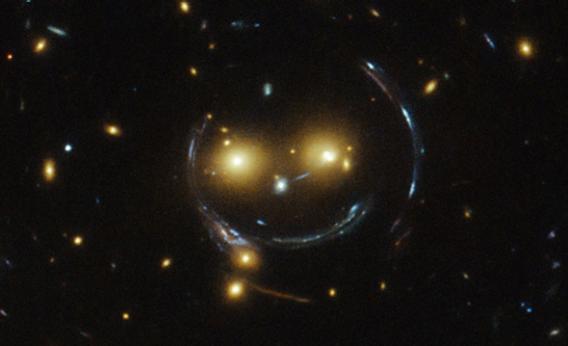Create a free profile to get unlimited access to exclusive videos, sweepstakes, and more!
Smile for the Cosmic Lens!

That picture above is real! It’s a Hubble Space Telescope image of a cluster of galaxies with the poetic name of SDSS J1038+4849 (called that because it was first seen in the Sloan Digital Sky Survey, and the numbers are its coordinates, like latitude and longitude, on the sky). What you’re seeing is a peculiar effect of relativity called “gravitational lensing.”
You know that gravity can bend the path of an object traveling in space; an orbit is just a path bent so much one object goes around another.
Gravity does this by bending space itself, warping it. A moving object follows that bend like a bobsled sliding along the twists and turns of its track. Any object … including light.
And that’s what you’re seeing. J1038 is a group of galaxies about 4.5 billion light-years away, and there are trillions of stars in the cluster. That’s a lot of mass, and a lot of gravity. Beyond it, at a distance of about 7.5 billion light years, lie more galaxies. The light from those galaxies passes by J1038 on its way to Earth, and travels through the region of space distorted by the galaxies’ gravity. This bends the light, acting like a giant lens made of gravity (hence the term gravitational lens, of course).
There are lots of ways the light can bend. The simplest is in an arc shape, smearing out the shapes of the more distant galaxies. In cases where the lensing and lensed galaxies line up just right, you can get a ring of light around the lensing galaxy! Lensing can also create multiple copies of a background galaxy (this is called an Einstein Cross) and even make the more distant galaxy appear much brighter.
In J1038, the eyes are two elliptical galaxies in the lensing cluster, and the nose is a smaller galaxy (it may or may not be part of the lensing cluster). The smile and the sides of the head are actually the much more distant galaxies, distorted into arcs.
Lensing is more than just a quirk; it’s actually a powerful tool used by astronomers. Many background galaxies are too faint to study on their own, but lensing can make them bright enough to study. It also tells us about the mass of the galaxies doing the lensing, and even the distribution of invisible dark matter in the cluster—normally it can’t be detected easily, but dark matter has mass and therefore gravity, and it contributes to the lensing.
Lensing is pretty handy, and it’s a circumstance that makes a lot of astronomers happy. I’m not one to push a metaphor too much, but sometimes it does feel like the Universe is smiling on us.


























